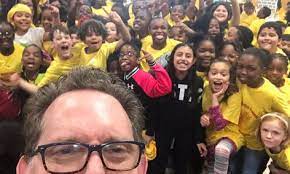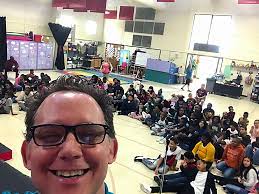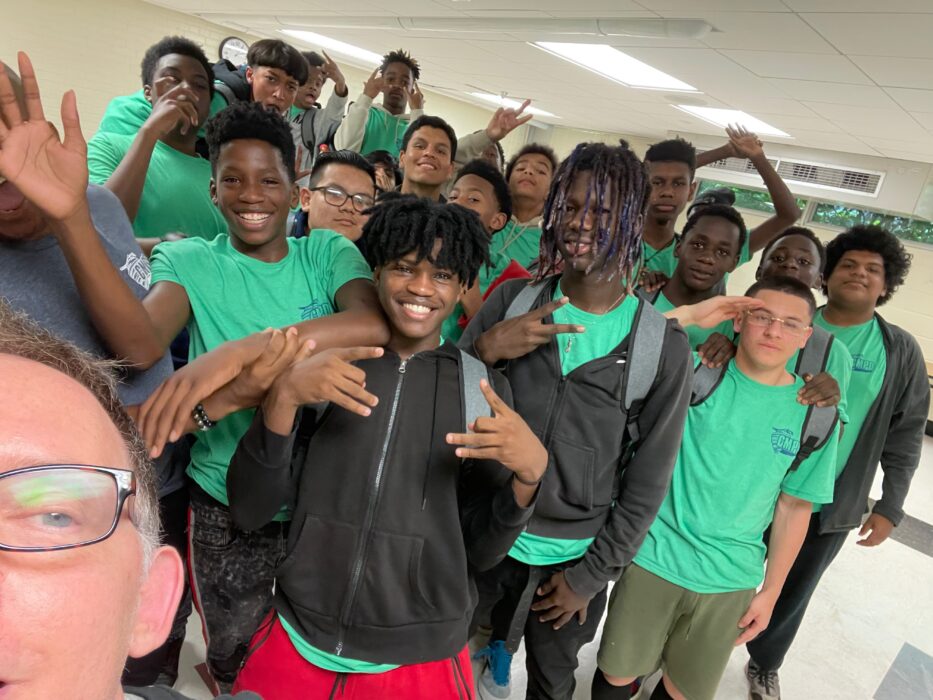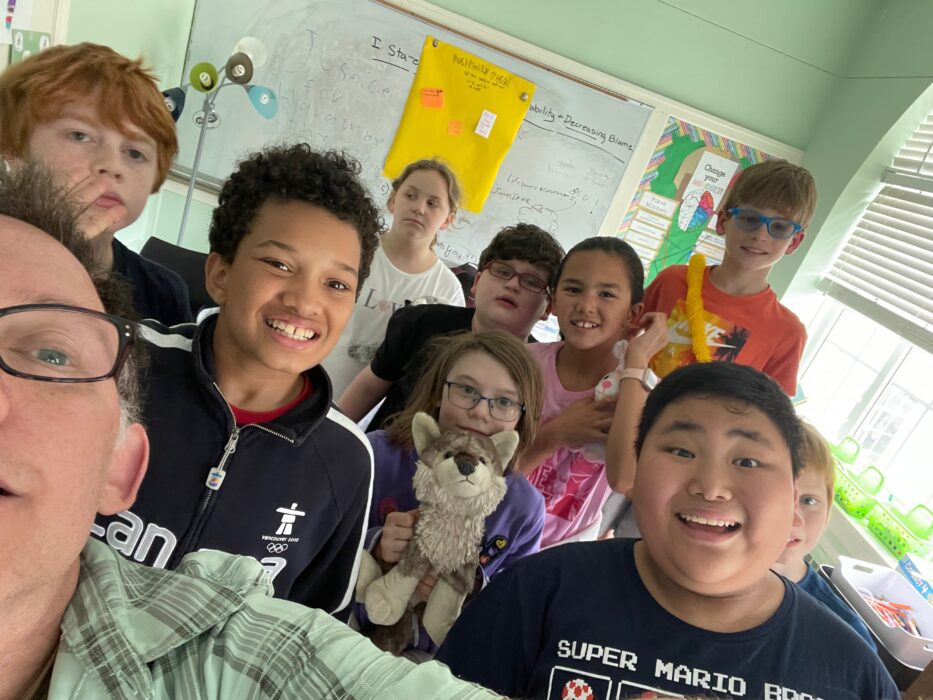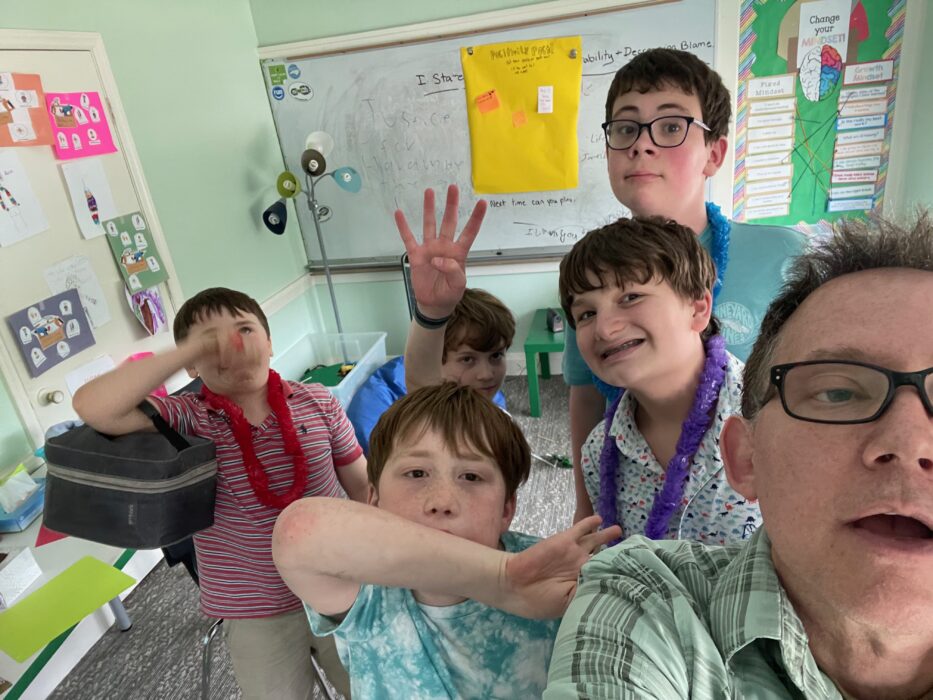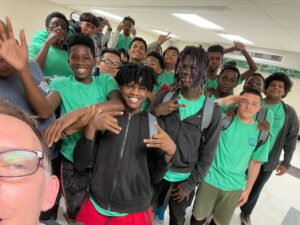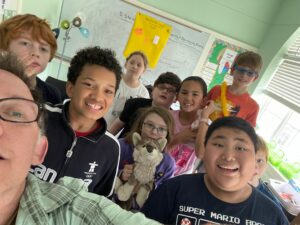Planet Improv Educational Services, LLC & Planet Improv, Inc.

Planet Improv Educational Services, LLC is a for-profit business established in 2019 that uses applied improvisational theatre techniques to empower and educate students.
Planet Improv, Inc is a 501c3 nonprofit corporation established in 2006. Its’ mission statement is “Empowering resilience
…
View moreEducator CONTACT INFO
SELECT A PROGRAM
Planet Improv Offers Applied Improvisational Sessions “Improv for Healing”

Program Description
Improv for Healing presents students with an opportunity for connection. Through examining different types of distorted thinking (thinking that leads to a negative mood) participants gain clarity and mindfulness in regard to their patterns in day-to-day life. Students will utilize distorted thinking patterns to strengthen their improv skills. By practicing reflective listening, communication, and
...Booking / scheduling contact
Program Detail
We will work with you and your students to find a mutually convenient day/date.
We will work with you and your students to find a mutually convenient timeframe.
Can we stand up, sit down and move around a little?
We come to your location.
We will work with you to stretch your grant money as far as possible to allow your students as many teaching artists experiences as possible.
EDUCATION STANDARDS
ARTS EDUCATION – NC STANDARD COURSE OF STUDY (KINDERGARTEN THROUGH 12TH GRADE)
KINDERGARTEN
COMMUNICATION
K.C.1 Use movement, voice, and writing to communicate ideas and feelings.
K .C .1 .1 Use non-verbal expression to communicate movement elements . K .C .1 .2 Recognize how vocal variety is used to demonstrate feelings . K .C .1 .3 Use drawing (pre-writing) to communicate the main idea of stories .
K.C.2 Use performance to communicate ideas and feelings.
K .C .2 .1 Use dramatic play to improvise stories and situations . K .C .2 .2 Use dramatic play to re-enact stories from texts read aloud .
ANALYSIS
K.A.1 Analyze literary texts and performances.
K .A .1 .1 Recall the basic parts of a story, such as characters, setting, and events .
K .A .1 .2 Analyze events in relationship to the setting where they take place in formal and informal productions .
CULTURE
K.CU.2 Understand the traditions, roles, and conventions of theatre as an art form.
K .CU .2 .1 Understand how to attend to others when they are sharing . K .CU .2 .2 Recognize the role of the director or acting coach .
1ST GRADE
COMMUNICATION
1.C.1 Use movement, voice, and writing to communicate ideas and feelings.
1 .C .1 .1 Use non-verbal expression to communicate movement elements, including size, weight, and rate .
1 .C .1 .2 Use creative drama techniques, such as storytelling or puppetry, to demonstrate vocal variety .
1 .C .1 .3 Understand that stories have a beginning, middle, and end .
1.C.2 Use performance to communicate ideas and feelings.
1 .C .2 .1 Use improvisation to communicate activities in a variety of situations . 1 .C .2 .2 Use dramatic play to perform stories while texts are read aloud .
ANALYSIS
1.A.1 Analyze literary texts and performances.
1 .A .1 .1 Analyze texts in terms of the relationships among characters, setting, and events .
1 .A .1 .2 Explain qualities of characters and sequence of events in formal and informal productions .
CULTURE
1.CU.1 Analyze theatre in terms of the social, historical, and cultural contexts in which it was created.
1 .CU .1 .1 Recognize how theatre is used in customs and traditions of various cultures .
1 .CU .1 .2 Compare the impact of different media, such as theatre, film, the Internet, and television, on family life .
1.CU.2 Understand the traditions, roles, and conventions of theatre as an art form.
1 .CU .2 .1 Understand how to use appropriate behavior as an audience member . 1 .CU .2 .2 Use appropriate responses to the director or acting coach .
2ND GRADE
COMMUNICATION
2.C.1 Use movement, voice, and writing to communicate ideas and feelings.
2 .C .1 .1 Use non-verbal expression to communicate elements of characterization, including age and physicality .
2 .C .1 .2 Use vocal variety and animation to create distinct voices for characters . 2 .C .1 .3 Use dialogue to enhance the clarity of stories .
2.C.2 Use performance to communicate ideas and feelings.
2 .C .2 .1 Use improvisation to communicate problems and resolutions . 2 .C .2 .2 Interpret stories from previously-read texts by acting them out .
ANALYSIS
2.A.1 Analyze literary texts and performances.
2 .A .1 .1 Distinguish the setting, characters, sequence of events, main idea, problem, and solution for a variety of stories .
2 .A .1 .2 Analyze the relationships between events, characters, and settings .
CULTURE
2.CU.1 Analyze theatre in terms of the social, historical, and cultural contexts in which it was created.
2 .CU .1 .1 Exemplify theatrical works representing the heritage, customs, and traditions of various cultures .
2 .CU .1 .2 Explain the impact of media, such as theatre, film, the Internet, and television, on family life .
2.CU.2 Understand the traditions, roles, and conventions of theatre as an art form.
2 .CU .2 .1 Illustrate how to share focus with others in a group setting . 2 .CU .2 .2 Summarize the role of the director or acting coach .
3RD GRADE
COMMUNICATION
3.C.1 Use movement, voice, and writing to communicate ideas and feelings.
3 .C .1 .1 Use non-verbal expression to communicate elements of characterization, including age and physicality .
3 .C .1 .2 Apply appropriate volume and variation in pitch, rate, and tone to express character . 3 .C .1 .3 Understand how to transform stories into written dialogue .
3.C.2 Use performance to communicate ideas and feelings.
3 .C .2 .1 Use improvisation to present a variety of simple stories or situations . 3 .C .2 .2 Interpret stories from given texts by acting them out .
ANALYSIS
3.A.1 Analyze literary texts and performances.
3 .A .1 .1 Differentiate specific character traits in texts or scripts .
3 .A .1 .2 Evaluate informal or formal theatre productions in terms of the emotions or thoughts they evoke .
CULTURE
3.CU.1 Analyze theatre in terms of the social, historical, and cultural contexts in which it was created.
3 .CU .1 .1 Exemplify how theatre arts are used by various groups for artistic expression within the local community
3 .CU .1 .2 Explain how theatre, film, and television impact our society .
3.CU.2 Understand the traditions, roles, and conventions of theatre as an art form.
3 .CU .2 .1 Illustrate theatre etiquette appropriate to the performance situation .
3 .CU .2 .2 Understand the role of the actor in relation to performance responsibilities, such as memorization, blocking, and characterization .
4TH GRADE
COMMUNICATION
4.C.1 Use movement, voice, and writing to communicate ideas and feelings.
4 .C .1 .1 Use a variety of postures, gaits, and mannerisms to express character in the presentation of stories .
- 4 .C .1 .2 Apply appropriate vocal elements of volume, pitch, rate, tone, articulation, and vocal expression to various types of literature and storytelling .
- 4 .C .1 .3 Understand how to adapt sources, such as literature texts, poetry, and speeches, into scripts .
4.C.2 Use performance to communicate ideas and feelings.
4 .C .2 .1 Use improvisation to tell stories and express ideas .
4 .C .2 .2 Interpret multiple characters from stories through use of the body and voice .
ANALYSIS
4.A.1 Analyze literary texts and performances.
4 .A .1 .1 Analyzetextsorscriptsintermsofspecificcharactertraitsandrelationshipsamongthem .
4 .A .1 .2 Critique choices made about characters, settings, and events as seen, or portrayed in, formal and informal productions .
CULTURE
4.CU.1 Analyze theatre in terms of the social, historical, and cultural contexts in which it was created.
4 .CU .1 .1 Understand how theatre arts have affected, and are reflected in, the culture, traditions, and history of North Carolina .
4 .CU .1 .2 Create theatrical works that exemplify aspects of the culture, beliefs, and history of North Carolina .
4.CU.2 Understand the traditions, roles, and conventions of theatre as an art form.
4 .CU .2 .1 Use critiques to improve performances .
4 .CU .2 .2 Understand the role of the playwright in relation to script construction techniques, such as dialogue, protagonist, and antagonist .
5TH GRADE
COMMUNICATION
5.C.1 Use movement, voice, and writing to communicate ideas and feelings.
5 .C .1 .1 Use a variety of postures, gaits, and mannerisms to express a variety of characters in the presentations of stories .
- 5 .C .1 .2 Apply appropriate vocal elements of volume, pitch, rate, tone, articulation, and vocal expression in various types of formal and informal presentations .
- 5 .C .1 .3 Construct original scripts using dialogue that communicates ideas and feelings .
5.C.2 Use performance to communicate ideas and feelings.
5 .C .2 .1 Use improvisation to create characters and solve problems .
5 .C .2 .2 Interpret various characters from different genres of given texts through the use of the body and voice .
ANALYSIS
5.A.1 Analyze literary texts and performances.
5 .A .1 .1 Analyze texts or scripts in terms of setting, characters, sequence of events, main idea, problem, solution, and their interrelationships .
5 .A .1 .2 Evaluatehowintendedmeaningsareconveyedthroughformalandinformalproductions .
CULTURE
5.CU.1 Analyze theatre in terms of the social, historical, and cultural contexts in which it was created.
5 .CU .1 .1 Understand how theatre arts have affected, and are reflected in, the culture, traditions, and history of the United States .
5 .CU .1 .2 Create theatrical works that exemplify aspects of the culture, beliefs, and history of the United States .
5.CU.2 Understand the traditions, roles, and conventions of theatre as an art form.
5 .CU .2 .1 Use strategies to critique self and others in a respectful and constructive manner .
5 .CU .2 .2 Understand the role of the director in relation to staging techniques, such as cheating out, blocking, and levels .
6TH GRADE
COMMUNICATION
6.C.1 Use movement, voice, and writing to communicate ideas and feelings.
6 .C .1 .1 Use physical movement and acting skills to express a variety of emotions to an audience .
6 .C .1 .2 Apply appropriate vocal elements of volume, pitch, rate, tone, articulation, and vocal expression .
6 .C .1 .3 Understand how to read and write scripts .
6.C.2 Use performance to communicate ideas and feelings.
6 .C .2 .1 Use improvisation and acting skills to role play various scenarios and given situations . 6 .C .2 .2 Interpret various selections of literature through formal and informal presentations .
ANALYSIS
6.A.1 Analyze literary texts and performances.
6 .A .1 .1 Analyze plays in terms of theme, characters, conflict, and their interrelationships .
6 .A .1 .2 Analyze informal or formal theatre productions in terms of the emotions or thoughts they evoke, characters, settings, and events .
CULTURE
6.CU.1 Analyze theatre in terms of the social, historical, and cultural contexts in which it was created.
6 .CU .1 .1 Understand theatre arts in relationship to the geography, history, and culture of world civilizations and societies from the beginning of human society to the emergence of the First Global Age (1450) .
6 .CU .1 .2 CreatetheatricalworksthatexemplifythestyleandcultureofEuropeandSouthAmerica .
6.CU.2 Understand the traditions, roles, and conventions of theatre as an art form.
6 .CU .2 .1 Summarize the rules and purpose of audience etiquette .
6 .CU .2 .2 Understand the roles of actors and directors in creating performances .
7TH GRADE
COMMUNICATION
7.C.1 Use movement, voice, and writing to communicate ideas and feelings.
7 .C .1 .1 Use physical movement and acting skills to express a variety of characters to an audience .
7 .C .1 .2 Apply appropriate vocal elements, such as pitch, volume, and projection, effectively in formal and informal presentations .
7 .C .1 .3 Use playwriting skills to communicate conflict, plot, and character .
7.C.2 Use performance to communicate ideas and feelings.
7 .C .2 .1 Use acting skills, such as observation, concentration, and characterization, to perform original scenes .
7 .C .2 .2 Interpret a character from literature through formal and informal presentations .
ANALYSIS
7.A.1 Analyze literary texts and performances.
7 .A .1 .1 Analyze plays in terms of theme, characters, conflict, and dialogue . 7 .A .1 .2 Analyze styles of informal and formal theatre productions .
CULTURE
7.CU.1 Analyzetheatreintermsofthesocial,historical,andculturalcontextsinwhichitwas created.
7 .CU .1 .1 Understand theatre arts in relationship to the geography, history, and culture of modern societies from the emergence of the First Global Age (1450) to the present .
7 .CU .1 .2 Create theatrical works that exemplify the style and culture of Africa, Asia, and Australia .
7.CU.2 Understand the traditions, roles, and conventions of theatre as an art form.
7 .CU .2 .1 Compare the rules and expectations of audience etiquette for different venues . 7 .CU .2 .2 Understand the role of the playwright in relation to scripting theatre .
8TH GRADE
COMMUNICATION
8.C.1 Use movement, voice, and writing to communicate ideas and feelings.
- 8 .C .1 .1 Use physical movement and acting skills to express stories to an audience .
- 8 .C .1 .2 Apply appropriate vocal elements, such as pitch, volume, and projection, effectively while portraying characters .
- 8 .C .1 .3 Create original works that communicate ideas and feelings .
8.C.2 Use performance to communicate ideas and feelings.
- 8 .C .2 .1 Use acting skills, such as observation, concentration, and characterization, to perform original, written scenes .
- 8 .C .2 .2 Interpret multiple characters from literature through formal and informal presentations .
ANALYSIS
8.A.1 Analyze literary texts and performances.
- 8 .A .1 .1 Analyze plays in terms of theme, characters, conflict, dialogue, mood, and atmosphere .
- 8 .A .1 .2 Evaluate the theatrical quality of formal or informal theatre productions .
CULTURE
8.CU.1 Analyze theatre in terms of the social, historical, and cultural contexts in which it was created.
8 .CU .1 .1 Understand the role of theatre arts in North Carolina and the United States in relation to history and geography .
8 .CU .1 .2 Create theatrical works that exemplify the style and culture of North Carolina, the United States and/or North America .
8.CU.2 Understand the traditions, roles, and conventions of theatre as an art form.
8 .CU .2 .1 Use appropriate theatre etiquette as a participant in informal and formal theatre . 8 .CU .2 .2 Understand the roles of technical theatre in relation to theatrical productions .
-
***BEGINNING INTERMEDIATE HIGH SCHOOL PROFICIENT THEATRE ARTS***SEE STANDARDS AT LINK BELOW***
https://www.dpi.nc.gov/documents/cte/curriculum/healthfulliving/new-standards/arts/theatre/essential-standards-theatre-9/open
Qualifications
References
Teacher Amanda Lane
Amanda-Lane-Recommendation-1.pdfMain Social Worker Barry Sherman
Sherman-Recommendation-1.pdfPrincipal Jeff Cook
Letter-of-Recommendation-for-Scott-Pacitti-1.pdfCancellation Policy
We will work with you to reschedule any sessions for whatever reason.


